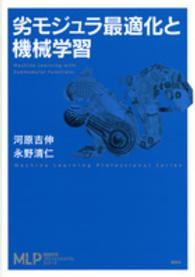- ホーム
- > 洋書
- > 英文書
- > Science / Mathematics
Full Description
Handbook of Electronic Structure Theory provides a much-needed learning resource that collects and demonstrates the various key methods involved in electronic structure theory, the feasibility and reliability of electronic structure calculations and their applications using computational chemistry, with a particular focus on the most modern and recent problems which are poorly covered in existing, largely outdated book literature. This handbook is designed with early career researcher learning in mind by aiming to provide a careful, structured, coherent, measured, and incremental presentation of the subject matter as well as appropriate problems and worked tutorial examples. Elements like summary boxes, worked examples, and downloadable data sets make this a holistic guide to the topic for learners from different backgrounds who require a deeper understanding of electronic structure theory.
Part I one of the book focuses on the critical core theories, before Part II moves on to some of the most important recent developments and their potential future directions, including key topics such as the electronic excited states and the harnessing of machine learning. Finally, Part III then collects a range of key case study examples of applications such as for biomolecules, in spectroscopy, or for use in catalysis amongst others.
Handbook of Electronic Structure Theory is written primarily for masters, PhD, and postdoctoral students in theoretical and computational chemistry as well as experimental researchers wishing to apply quantum chemical methods in a critical way. The book will also have significant relevance to those studying and teaching in the adjacent fields of computational physics, materials science, and astrochemistry, who are making use of electronic structure methods. It is also likely to be of interest to chemists working on designing new materials and compounds targeting industrial and environmental applications such as catalysis, energy harvesting or green chemistry.
Contents
Preliminaries
1. Basis Sets
2. Integral Evaluation
3. Numerically intensive steps (Linear and Tensor Algebra)
Part I. Key Theories
4. Introductory / Summary of state of the art of valence bond theory
5. Introductory / Summary of state of the art of Molecular Orbital Theory
6. Introductory / Summary of state of the art of Density Functional Theory Carlo Adamo
7. Introductory / Summary of state of the art of post-Hartree-Fock methods
8. Introductory / Summary of state of the art for focused methods (large systems and solutions)
9. Introductory / Summary of Quantum Computing
10. Introductory / Summary of state to the art of Artificial Intelligence in Theoretical Chemistry and Machine Learning based developments
11. Introductory / Summary of state to the art of beyond the Born-Oppenheimer approximation: Non-adiabatic effects in ET theory. Time-dependent dynamics.
Part II: Recent developments and future works
12. Many-body theories
13. Coupled Clusters
14. Local Correlation, PNO, etc.
15. Multireference methods
16. Excited electronic states
17. Green-function methods
18. Time dependent methods
19. Nuclear-electronic orbital (NEO) methods
20. Chemical concepts from computations
21. Density functional theory a) More accurate functionals (double-hybrids, explicit correlation, physical constraints) b) Large systems and approximated methods c) Dispersion and van der Waals complexes d) Density matrix e) Static correlation and multi-reference approaches f) Plane-waves, periodic systems and dynamics
22. Relativistic effects
23. Density matrix renormalization group (DMRG) based methods
25. QM-MM and related approaches
26. Machine Learning methods
27. Composite schemes in electronic structure computations
28. Non-equilibrium electronic properties: spin polarization and spin accumulation at interfaces
Part III: Applications and case studies
29. Ground state computations
31. Weakly bonded systems
32. Negative and positive ions and related spectroscopies
33. Rotational and vibrational spectroscopy including chiral molecules spectra
34. Electronic excited states and non-adiabatic effects computations
36. Computations of properties
37. Reaction Mechanisms
38. Gas phase kinetics
39. Studies in condensed phases
40. Interfaces, confined systems and nanosystems
41. Biomolecules
42. Catalysis (Enzymatic, Homogeneous, Heterogeneous)
43. (Multi-)Potential energy surfaces mapping for spectroscopy and dynamics
44. Anharmonicity and large amplitude motions
45. Gas phase kinetics
46. Studies in condensed phases
47. Interfaces, confined systems and nanosystems
48. Biomolecules
49. Catalysis (Enzymatic, Homogeneous, Heterogeneous)
50. (Multi-)Potential energy surfaces mapping for spectroscopy and dynamics
51. Anharmonicity and large amplitude motions
52. Energy Decomposition Analyses
53. SAPT (symmetry adapted perturbation theory)
54. Quantum theory of atoms in molecules (QTAIM)








